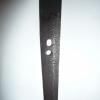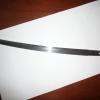Hi everybody. Could anyone help me with the identification of that mei on my wakizashi blade ? I believe the two first characters are dealing with a date (but which one ?), and I guess the three other ones are the swordsmith's name.
|
|||||||
 |
Nihonto ClubJapanese Sword Information Exchange |
User login |
|
|
Disclaimer: Nihontō Club owners and independent contributors will not be held responsible for any loss, damage or inconvenience caused as a result of any inaccuracy or error within this website. Except where otherwise noted, this page is licensed under a Creative Commons License.
|



maybe Tsugunari
It appears to be "BANZAI TSUGUNARI SAKU".
The phrase "banzai" or "kimi banzai" was used on blades by smiths such as Sukenari, Suketaka, Tomonari, etc. Note the second kanji in Sukenari and Tomonari is also "nari", so this blade could be related to those smiths. They are 19th century.
The "tsugu" kanji is old Nelson #3545 (KEI, tsugu).
Pete
why "banzai" or "kimi banzai" ?
Thanks a lot Pete for this quick and precise answer.
A few more questions if possible:
Do you mean that the blade was made either by Sukenari or Tomonari (with some sort of nickname "tsugu" used on that particular sword) or by a relative of them (son, family, clan) ?
Last thing: do you know why a few swordsmith used "banzai" or "kimi bazai" in their signature ? Was it a wish for the future owner of the sword or a simple tradition ?
banzai
Hi,
Perhaps your blade was made by a student or relative of those "X-nari" guys.
I don't know - just a guess - a place to start your research.
I don't know the significance of the "banzai" - it may be just a patriotic statement.
Pete
Maybe TSUGUSHIRO
After looking once again at this mei, I think the fourth kanji looks like more to a "shiro" than a "nari".
So the mei could be "BANZAI TSUGUSHIRO SAKU" and the swordsmith either tsugushiro TSU204 or TSU205.
The only problem that remains is that none of these swordsmiths is knowned to have ever use the "BANZAI" term in his mei.
Sylvain
Shiro
Yes, you're right - my wife agrees that it is DAI/SHIRO/YORI, not NARI.
Even though one small stroke is below the horizontal line (usually it is above), we have a book that shows this as an alternate way to write it.
Pete
Banzai
There looks to be two smiths from the same province as Tsugushiro who did use Banzai in their signature, Tsugutsune and Tsuguyoshi. Not too far fetched to think Tsugushiro may also have used it at some point.
Kimi Banzai (question for Pete)
Hi Pete,
As some kind of coincidence, I'm currently studying another sword signed 'Tomonari'. Can you tell me where I can read about the use of 'Kimi Banzai' by Sukenari, Suketaka, Tomonari etc?
Regards,
Stan
Banzai
Hi Stan,
I found the "kimi banzai" phrase by searching my old ToShoW database. It's in ToShoW because it was in Hawley. My wife says that "kimi" refers to the emperor, similar to the word TENNOu, which is the modern/common word for Emperor.
So, "Kimi Banzai" would be a patriotic cheer, more or less.
That's all I know about it.
The smiths in ToShoW that used the phrase are:
SUK761, 963
TOM134, 140
TOS322, 369
KAG86
(There could be more, because ToShoW doesn't include ALL of Hawley.)
There are several more that include just "banzai", without the "kimi".
Pete
Thank you, Pete, for your
Thank you, Pete, for your explanation.
S.